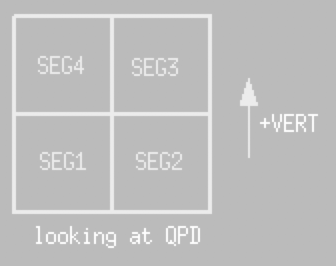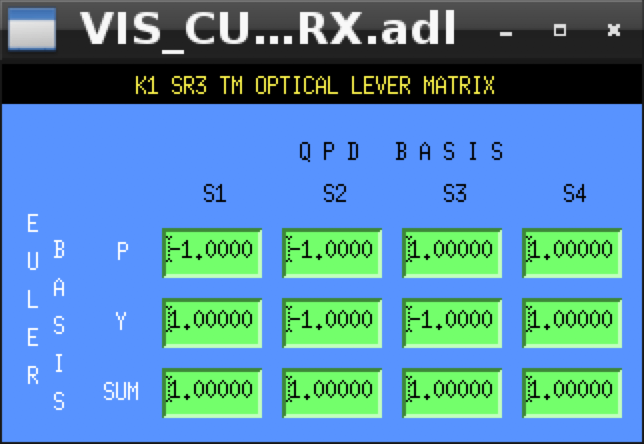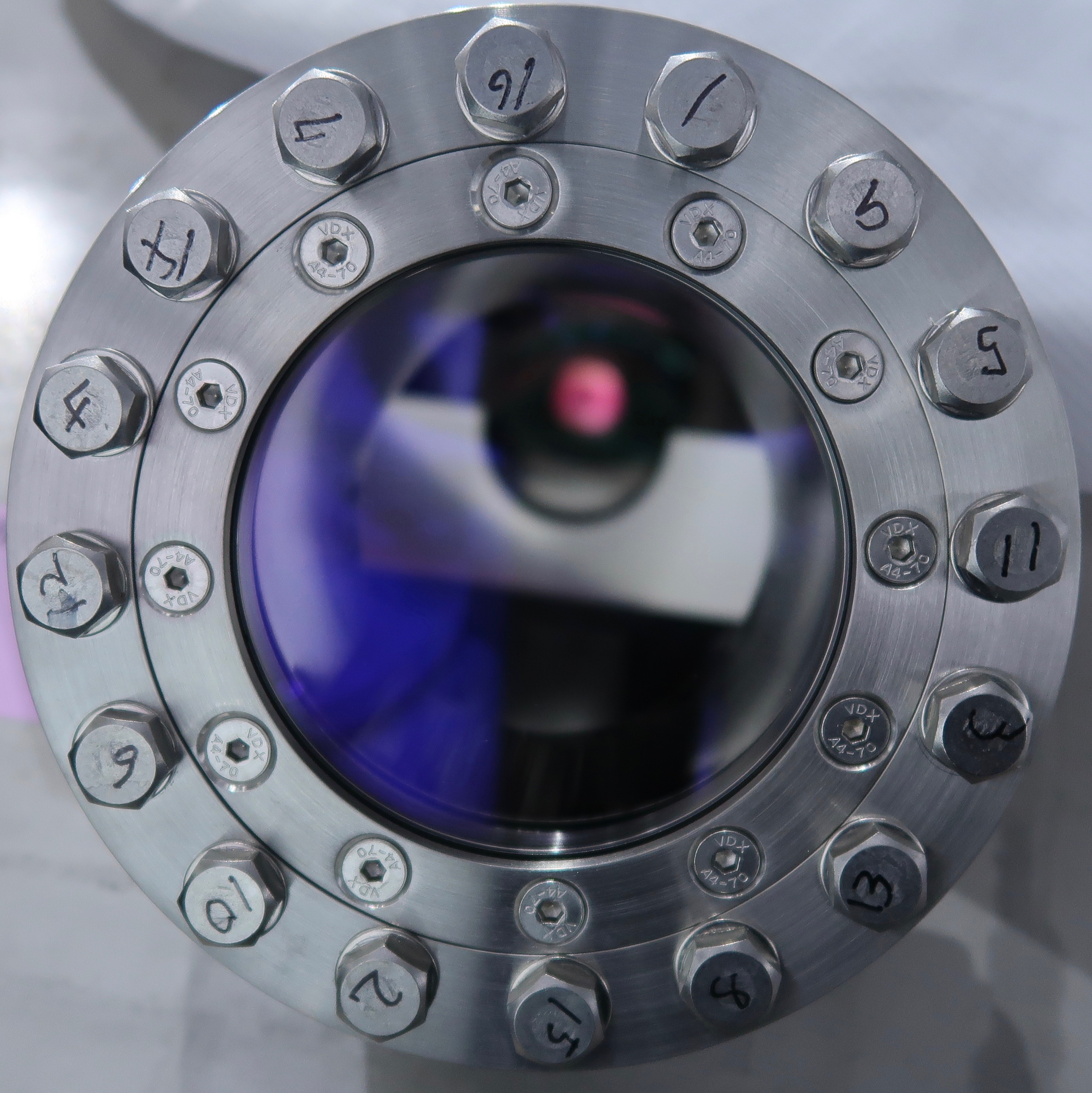KAGRA VIS Operations Manual - Optical Levers
Diagonalization procedure
This section is still in construction.
For obvious reason it is convent to follow one single diagonalization procedure for all the optical levers in KAGRA. Unfortunately, there are at least two methods.
Type A
Type Bp: procedure not documented.
Information
JGW-E1605527 - Optical levers (Oplevs) Tree Top
JGW-T1605788 - Length-Sensing OpLevs for KAGRA, writeup by Simon (also has info on beam profile for fibre with 3500 mm collimator)
JGW-T1503946 - OpLev, writeup by Ettore Majorana of VIRGO
JGW-T1707228 - Installation of OpLevs (manual)
JGW-T1504478 - Collimators and Focusers for Optical Levers (OpLevs) of KAGRA (has info on beam profile for fibre with 2500 mm and "1.1 m" collimators)
Data
KAGRA/Subgroups/AOS/DCQPDList - Inventory of QPDs for OLs
Quadrants

Default OL2EUL Matrix
The following matrix is appropriate if the OL beam is bounced off the AR side of the optic. Then, positive pitch of the optic (right-handed around transverse, nose-down) gives a high return beam, more light on SEG3 and SEG4, and positive P. Similarly, positive yaw of the optic (right-handed around vertical, nose-left) gives a return beam offset to the left (looking at the QPD), more light on SEG1 and SEG4, and positive Y.

Micrometer Function
Horizontal |
Vertical |
Notes |
Points right |
Points down |
viewed facing QPD |
Anticlockwise |
Anticlockwise |
turn of micrometer knob |
Retracts tip |
Retracts tip |
|
Larger numbers |
Larger numbers |
on micrometer scale |
Stage moves with tip |
Stage moves with body |
|
QPD moves left |
QPD moves down |
|
Spot moves to right quadrants |
Spot moves to upper quadrants |
|
Simulates -yaw |
Simulates +pitch |
|
Mechanical Installation
See D1808528 for the TX stand and D1808529 for the shelf, but note that the screw lists are missing the attachment screws.
Be sure to get all fasteners from AOL stock.
Stand Installation
Parts
- 1 pillar (pre-assembled)
- 1 interface plate
- 1 300x400 mm breadboard
Fasteners
- 6 x M8x20 socket head cap screw (not in D1808528)
- 6 M8 washers (not in D1808528)
- 3 x M12x150 threaded rod
- 9 x M12 hex nut
- 9 x M12 washer
- 4 x M6 washer
- 4 x M6x20 socket head cap screw
Tools
- M6 (5 mm) hex wrench
- M8 (6 mm) hex wrench
- Two wrenches for M12 (19 mm)
Procedure
- Clean the foot of the white frame where the pillar is to be mounted with wipes to remove dust and particles, and blow out the holes with the airgun.
- Orient the pillar so that one of the three M12 threaded holes in the top plate is towards the tank and the other two are away from the tank.
- Bolt the pillar down firmly with 6 x M8*20 with washers. If necessary, use ethanol to lubricate the screws during insertion (there may be paint residue in the holes). Check that the pillar does not rock and that the top plate is reasonably level.
- There are six Ø12 mm holes in the interface plate. Choose three in a pattern matching the holes in the pillar top plate.
- Put M12 lock nuts and washer on the ends of the three M12x150 rods, leaving about 20 mm to the end.
- Screw the three M12x150 rods into the interface plate from underneath until the ends are slightly below flush with the top surface. (They must not protrude above the surface, or the breadboard will not sit properly flat.)
- Screw the lock washers up to lock the rods into position.
- Add M12 lock nuts to the lower ends of the rods, leaving about 60 mm to the ends. Place M12 washers on the pillar top plate around the Ø12 mm holes.
- Stand the interface plate on top of the pillar so that the rods go through the holes and the lock nuts sit on the washers. Adjust the lock nuts until the interface plate is level and there is a gap of 74.6 mm between the plates.
- Add M12 washers and M12 lock nuts to the bottom of the rods and tighten.
Attach the breadboard with 4 x M6x20 with M6 washers inserted from below in the corners. (Note that for no good reason the TX breadboard uses M6x20 and the RX one uses M6x30. Do use the prescribed size to prevent confusion about stock levels.)
Shelf Installation
Parts
- 1 bay (pre-assembled)
- 1 300x400 mm breadboard
Screws
- 4 x M6 washer
- 4 x M6x20 socket head cap screw
- 4 x M12x60 hex head screw (not in D1808529)
- 4 x M12 spring washer (not in D1808529)
- 8 x M12 washer (not in D1808529)
- 4 x M12 hex nut (not in D1808529)
Tools
- M6 (5 mm) hex wrench
- Two wrenches for M12 (19 mm)
Procedure
- Put an M12 spring washer and an M12 regular washer on each M12 screw and insert the screws through the holes in the top of the bay and the matching holes in the tank frame.
- Add an M12 regular washer and M12 regular nut to each screw and tighten firmly.
Attach the breadboard with 4 x M6x30 with M6 washers inserted from below in the corners. (Note that for no good reason the TX breadboard uses M6x20 and the RX one uses M6x30. Do use the prescribed size to prevent confusion about stock levels.)
Viewports
Description below is for one viewport. Two are needed for the OL, and possibly a third for a camera. See E1707303 for instructions in Japanese by Miyo-kun.
Parts
- 1 viewport
1 Cu gasket Need to find size!!
Fasteners
- 16 M8x?? hex head screws (can be recycled from those that were holding the blank port cover)
- 16 M8 nuts (can be recycled from those holding that were holding the blank port cover)
- 16 special low-diameter washers
- 16 regular M8 washers (can be recycled from those that were holding blank port cover - keep 16 of 32).
Tools
- Torque wrench(es) covering the range 5-15 N.m
- Torque wrench socket for M8 hex head screws (13 mm)
- Torque wrench hex bit driver for M4 (3 mm)
- Wrench for M8 nuts (13 mm)
Procedure
- Remove the screws from the old port cover, leaving three screws at approximately 120° separation.
- Loosen the remaining screws a few turns and massage the port cover to break the seal with the Cu gasket.
- Remove the remaining screws and the port cover.
- Keep the Cu gasket on the old port cover for protection, and wrap them for possible later reuse.
- Separate the screws, washers and nuts and set aside 16 screws, 16 nuts and half of the 32 washers for immediate reuse. (The remaining 16 washers will be replaced with special ones.)
- Put one of the special washers on each screw.
- Open a viewport and a new Cu gasket and wipe them and the open port with an ethanol-soaked Vectra-Alpha wipe. Inspect for any damage to the edges that bite into the gasket.
- Have three of the screws handy for insertion in the next step, with regular washers and nuts.
- Insert the gasket into the recess in the port surround (for upward facing ports) or the viewport (for downward facing ports) and then mate the viewpoint with the opening, matching the small notches around the edge. Quickly insert three screws from the front and add the regular washers and nuts at the back, but leave them only gently finger-tight.
- Add the remaining screws, washers and nuts and leave them loose.
- Massage the viewport into position and check that it is well-centered and the gap is even all the way around. Gradually tighten all the screws to gentle finger-tightness.
- Number the screw heads with a marker according to the following scheme:
Set the torque wrench to 5 N.m and tighten all the screws in numerical order. While tightening each screw, have an assistant hold the nut at the back with an open-ended wrench to stop it moving. Be very careful not to touch the viewport glass with the wrenches.
- Increase the torque wrench setting to 10 N.m and repeat.
- Increase the torque wrench setting to 15 N.m and repeat.
- Make a label with pink tape and oil-based pen, with the date, torque wrench setting and your name, and attach it to the tank near the viewport.
- Make a note of the viewport serial number and include it in a klog.

